* DGG(Deutsche Grammophon
Gesellschaft)
- 5 & 6-digits catalogue and jackets ; Introduction
- Any suggestion and contribution of better images and recording data will be welcomed and mentioned in this page.
- Special thanks to ; John Edward's 'Deutsche Grammophon Appreciation' site. His work on web DGG catalog is monumental. In case of using his page, I marked by light blue background color(on the contrary, in case there is no data in his page, I marked by light red background). And Mr. HOSOYA Junji added me invalueable infomations about all the issues of DGG old LPs and images.
- Of course also thanks so much to the owner of mikrokosmos.com who offered me the hosting space.
Index of numbers & jackets
| 10" | 16 | 001~050 | 051~100 | 101~150 | 151~200 | 201~250 | 251~300 | 301~350 | 351~400 | 401~450 | |
| 17 | 001~050 | 051~100 | 101~150 | 151~200 | |||||||
| 133(17) | 001~050 | 051~100 | 101~150 | 151~200 | 201~250 | 251~300 | |||||
| 12" | 18 | 001~050 | 051~100 | 101~150 | 19 | 001~050 | |||||
| 136(19) | 001~050 | 051~100 | 101~150 | 151~200 | 201~250 | 251~300 | 301~350 | 351~400 | 401~450 | 451~500 | |
| 501~550 | 551~600 | 601~650 | 651~700 | 701~750 | 751~800 | 801~850 | 851~900 | 901~950 | 951~999 | ||
| 138(18) | 001~050 | 051~100 | 101~150 | 151~200 | 201~250 | 251~300 | 301~350 | 351~400 | 401~450 | 451~500 | |
| 501~550 | 551~600 | 601~650 | 651~700 | 701~750 | 751~800 | 801~850 | 851~900 | 901~950 | 951~000 | ||
| 139(39) | 001~050 | 051~100 | 101~150 | 151~200 | 201~250 | 251~300 | 301~350 | 351~400 | 401~450 | 451~500 | |
| 501~550 | 551~600 | 601~650 | 651~700 | 701~750 | 751~800 | 801~850 | 851~900 | 901~950 | 951~999 |
0. Why I made a page about DGG
DGG is surely most notable recording company
between 1970s and 1980s (though unfortunately its leading
position was lost from 1990s mainly by many independent
labels like Naxos, Astrée, Brilliant, etc.),
but its history is long. Its root is same to EMI and RCA,
but its real independent history began in early 1950s,
selecting the tulip logo. If you'd like to see more
detailed explanations, go to DGG's 'About us'
page.
Anyway, in 1950s and 1960s DGG's
issues are very interesting in aspect of both cover
design and recording quality. Its introduction of stereo
technique was somewhat late but the early issues of them
is pleasant to listen because of the good vinyl quality
and cover design. In special I love DGG's covers - simple
and clean. Therefore, it is never old so far and revived
as The Originals series cover. Moreover, DGG's
early issues are not so expensive in general compared to
ones by HMV, UK Columbia, Decca, and French labels.
One can know
there are many vacant numbers in my lists. I believe the
vacancy really existed because I traced the stereo
serials more than two years, but cannot have confidence
by 100% as I was so only unlucky that I was not able to
find them until now. John Edward's
'Deutsche Grammophon Appreciation' site(alas this site is dead as of 2009) is
monumental but it is not perfect either. I restrained my
page only to DGG label's '5 & 6 number' issues which
have 16~19 *** and 136~ , 138~, and 139~ serials, but
there is uncertainty yet.
This is a small tribute to Deutsche Grammophon Gesellschaft, a very good recording company.
I. Monaural era
1. Front jacket
The 5-digit LPs (16/17 *** for 10
inch, 18/19 *** for 12 inch) released by DG have several
characteristics.
At the earliest times, the jacket
has the next characteristics;
- 16/18 series ; blue-taped at left side with dark yellow background(label; normally GY1)
- 17/19 series ; I saw 'white-yellow-white' at a few title, but am not sure if it was the general first style. In many cases 'W-Y-W' style is only seen at very early numbers.
 |
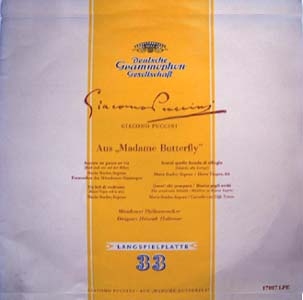 |
| 5 earliest style of 16/18 series | 5 earliest style of 17/19 series |
In general in this era, LPs are 'folder-jacketed'.
At the next era the jackets were changed;
- 16/18 series ; 'white-yellow-white' background(label; GY2 or GY3, rare GY1)
- 17/19 series ; stylized drawing(photographies were not used often) with DGG tulip logo backgrounded as 'white-yellow-white'(label; normally GY2).
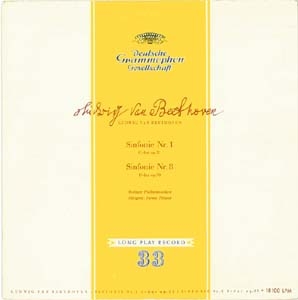 |
 |
| 5 The second style of 16/18 series | 5 The second style of 17/19 series |
At the third era, the styles of both the series are same. Labels are GY3 in general.
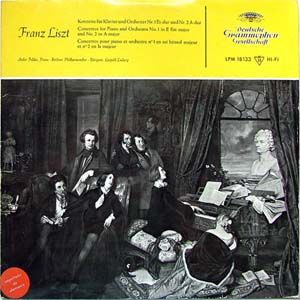 |
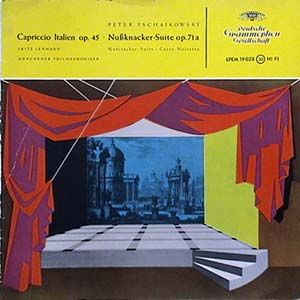 |
| 5 The third style of 16/18 series | 5 The third style of 17/19 series |
At the stereo era, jacket style is same to that of stereo issues. Of course, there is no center 'STEREO' script.
 |
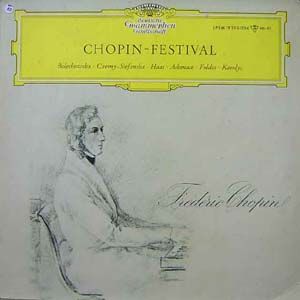 |
| 5 The last style of 16/18 series | 5 The last style of 17/19 series |
II. Stereo era
1. Logo at front jacket
Naturally, stereo
mark can be found in the jacket ; letter style can be
classified as 'Thin STEREO' and 'Bold STEREO', and the
former is the earlier one.
The
first style of the 6-digit LPs stereo issue is similar to
those of monaural second one, but 'yellow-white-yellow'
colored compared to 'white-yellow-white(W-Y-W)' jacket of
monaural issues. Tulip logo and
DGG mark began to be in the rim like picture frame,
so-called 'DGG catouche'.
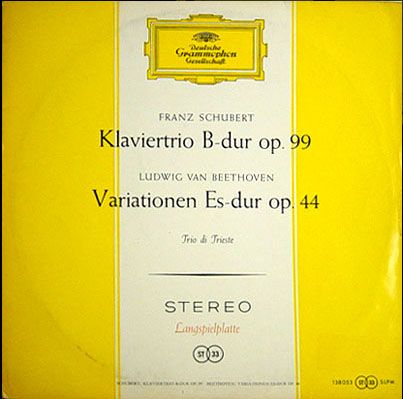
5 First catouche & 'Thin STEREO'
This style can be found in 138 early numbers, but I don't know whether this is true to 136 early issues(perhaps not). This 'Y-W-Y' jacket has STEREO logo at the center, which is written in thin block letter(not boldtype).
The first issue of the 6-digit LPs (133 ***, 136 ***, 138 ***, 139 ***) released by DG has big wide yellow catouche at the top of front jacket except for box albums. The first big catouche has the next characteristics;
- 'Deutsche Grammophon Gesellschaft' at the upper center
- 'record number + ST 33 in two small circles each + SLPEM(136~)/SLPM(138 & 139~)/SLP(133~)' at the upper right
- 'Thin STEREO' letter at the lower center.

5 Second catouche with 'Thin STEREO'
'Thin STEREO' and 'Bold STEREO' are different though not easy to discern. Please compare 'Thin STEREO' to the later 'Bold STEREO'.

At the next catouche 'Thin STEREO' was changed to 'Bold STEREO'. First 'Bold STEREO' is the yellow 'STEREO' letter backgrounded by red color, so-called 'Red Stereo' mark at the lower center.

5 Third catouche with 'Red stereo'
I think this 'Red stereo' logo
exists until 138 999 SLPM, but 138 999 was released very
early(May 1962). In general, 'Red stereo' was used at all
the issues till 1965 approximately. After 139 ***, red
stereo disappeared even at the first release jacket.
There are red-backgrouded sticker
on the early titles. Examples ;
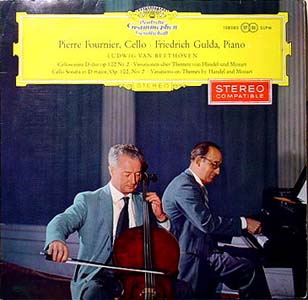 |
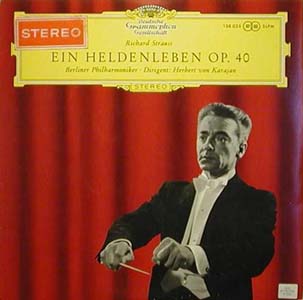 |
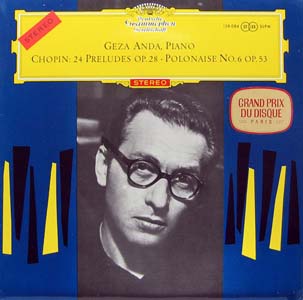 |
This is generally called 'Red Sticker', three kinds of which I have seen so far; small-sized sticker with 'STEREO' by black letter(right image), large-sized sticker with 'STEREO' by white letter(center), and large-sized sticker with 'STEREO COMPATIBLE' by white letter(left). I guess at the earliest titles there was no Red Stereo but only Red Sticker. [ I know several very early issues with bold stereo(but not red stereo) and without red sticker, but cannot have confidence whether this is general or not as they are fairly scarce. ]
At the fourth catouche logo, 'Red stereo' is displaced with yellow background and black bold letter. 'Deutsche Grammophon Gesellschaft' is not changed.

5 Fourth catouche ; 'DGG at center'
At the fifth, 'Deutsche Grammophon Gesellschaft' is changed to 'Deutsche Grammophon'.

5 Fifth catouche ; 'DG at center'
At the sixth, SLP(E)M disappears.

5 Sixth catouche
At the seventh(the last), ST 33 in small circle mark disappears.

5 Seventh catouche
The sequece above is rule-of-thumb and commonsense in LP lovers. However, DGG at center logos without SLPM or ST 33 Mark exist.

It seems that many logos existed
during the transition period to 7-digits serial issues.
At 138 780~800 releases, next style
'no ST 33 mark' can be seen.

The jacket styles are all similar. Example is 138 788(image below) - stereo letter is moved to upper right. This jacket is 'Red stereo'.
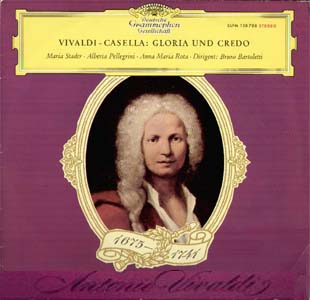
Though scarce, several issues have 'hybrids' of stereo at center and no ST 33 mark.

In the early serials(generally to red stereo era), there are jackets made by thick hard paper(hardcover editions). These have 'Direct Import - Factory sealed' at upper left and written in English in yellow logo, which alludes these maybe for American market(in USA, DGG's licensee was USA Decca and several titles were pressed by RCA). However, it seems to make special prints for direct export by DGG). German jacket issues utilized various fonts on yellow label for performer and works, but this hardcover prints only one. See below;

Another case of performer name and contents written in English is 'black square' at upper right, righter than SLP(E)M. See below;

Performers' names are written in English. I guess this for UK, but uncertain.
2. Label
The label style can be observed at the recent 'The originals' series CD. So-called 'big tulips' or 'tulip rim'. 'No tulip' label is later one. 'G**' notation is from mikrokosmos.com.
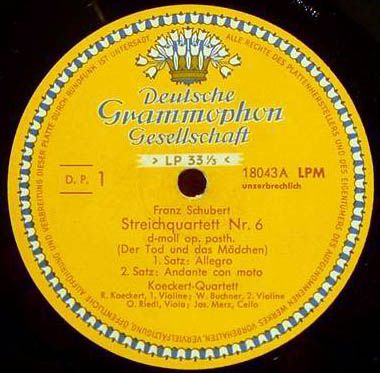 |
3 The
first label at monaural era has only German at
inner perimeter than 'tulip rim'. In 1 and 2
o'clock direction, 'ALLE RECHTE~ ' is seen.
'LP 33 1/3' mark is above the center hole, on
white background. In general, this is called
'Alle Rechte~ ', or simply 'GY1(German
Yellow 1st)'. |
 |
3 The
second label has only German at inner perimeter
like 'Alle Rechte'. In 1 and 2 o'clock direction,
'ALLE HERSTELLER' is seen. In general, this is
called 'Alle~ ' or 'Alle Hersteller~ ', or simply
'GY2(German Yellow 2nd)'. 'M33'
is at the rightside of the center hole, in
square. |
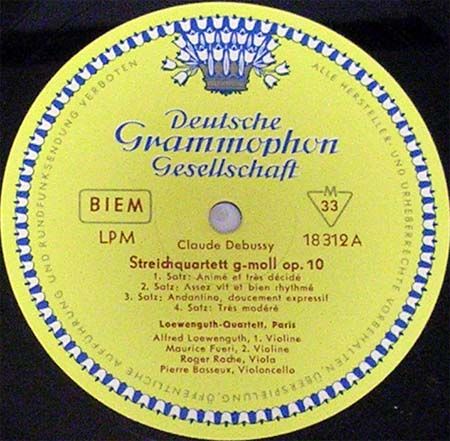 |
3 The
third is 'ALLE HERSTELLER' is also seen, but M33
mark is in triangle. In general, this is
called 'Alle~ ' or 'Alle Hersteller~ ', or simply
'GY3(German Yellow 3rd)'.
Backgrounded yellow color is brighter than GY1
and GY2. |
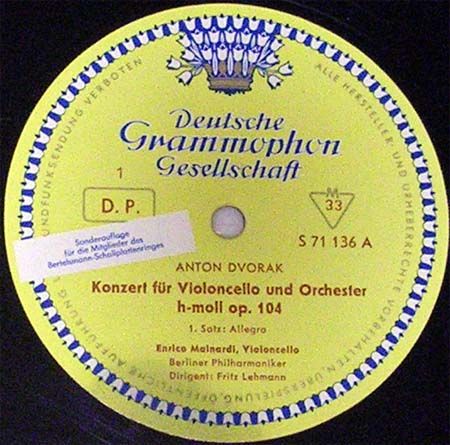 |
3 Club
edition of the monaural 'ALLE HERSTELLER' is also
seen. White mark is NOT sticker but printed
on label. In general, this is treated same
to 'Alle Hersteller~ ', or simply 'GY4(German
Yellow 4th)'. |
 |
3 The
stereo first label has same 'ALLE HERSTELLER',
but . In general, this is called 'Alle~ ' or
'Alle Hersteller~ ', or simply 'GY5(German
Yellow 5th)'. |
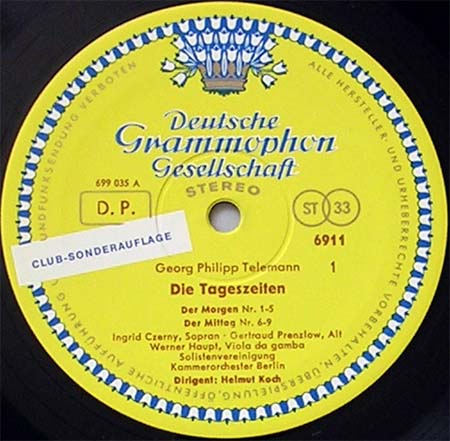 |
3 Club edition of stereo 'Alle Hersteller~ '. In general, this is called 'Alle Hersteller~ ' or simply 'GY6(German Yellow 6th)'. |
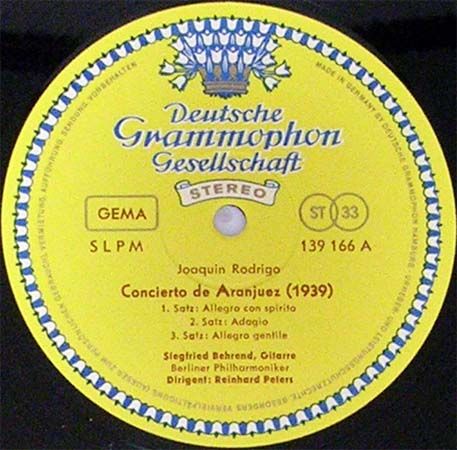 |
3 The first label has both German and English words at inner perimeter than 'tulip rim'. In 1 and 2 o'clock direction, 'MADE IN GERMANY' is seen. In general, this is called 'Made in Germany' or simply 'GY7(German Yellow 7th)'. |
 |
3 Scarce label sample. This label has 'Alle Hersteller~ ' in 5 o'clock direction, but 'Made in Germany' in 1~2 directions. This is treated as 'Alle~ ' in general, I guess. |
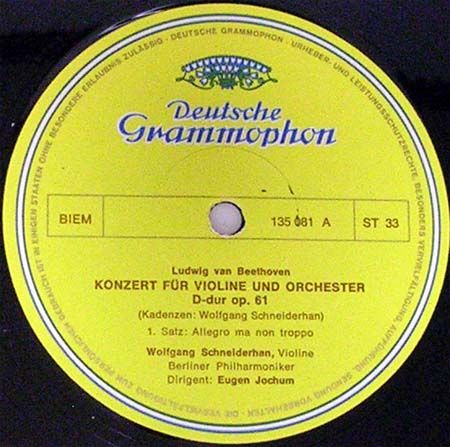 |
3 The First 'No tulip rim' label, at later pressings same to those of 7-digits numbers(25** *** or 27** ***) and reissues of the earlier recordings, or simply 'GY9(German Yellow 9th)'. At 12 o'clock direction, there is 'Deutsche Grammophon~ '. While the notation number is 9, this is perhaps the earlier than GY8. Thanks to Mr. Volker Mueller. |
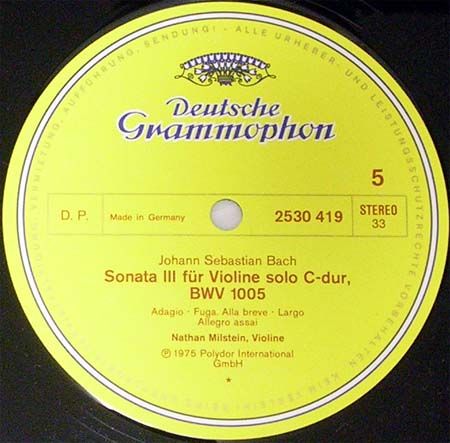 |
3 Second 'No tulip' label, or simply 'GY8(German Yellow 8th)'. At 12 o'clock direction, there is 'Alle Urherber~'. |
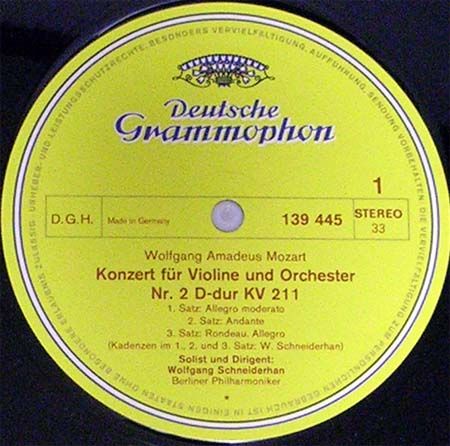 |
3 Third 'No tulip' label, at 2~3 o'clock direction there is 'Sendung vorbehalten'. Called simply 'GT2'. |
 |
3 The last 'No tulip' label in digital recording era. |
3. Nota bene
In stereo era, they say 'Red stereo' is equal to 'Alle Hersteller' and 'DGG at center' to 'Made in Germany' generally. However, to say exactly, logo style change is a bit different than label change.
- Can Alle
hersteller be in DGG at center(not
Red Stereo) jacket?
YES. In case of 139 000~139 130 numbers, the first pressing of them can be Alle hersteller though their jacket is only DGG at center. - Is Made in
Germany be in DG at center jacket?
YES, though I cannot upload the image. - Are all the
7-digit numbers releases No tulip and DG
at center jacket?
NO. Early 7-digit numbers have Made in Germany, and DGG at center jacket. See the image below, which clearly shows 7-digit number can have DGG at center jacket even with 'ST 33' SLPM mark.
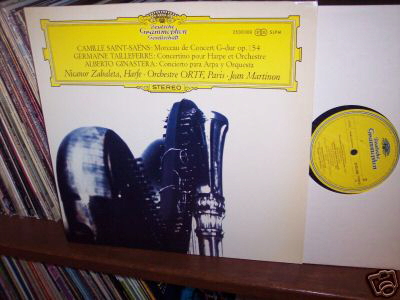
- Then, can No
tulip be in DGG at center jacket?
YES. I have one example, moreover at 'factory sealed' status. One example ;
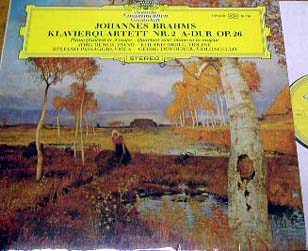
Keep in mind that there can be more than one designs in a number. I saw maximum seven designs a number.
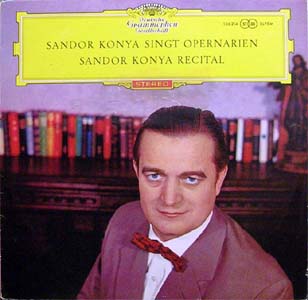 |
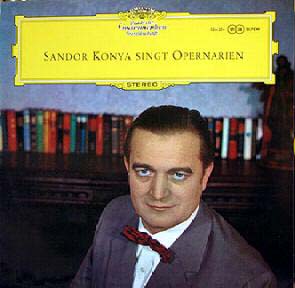 |
 |
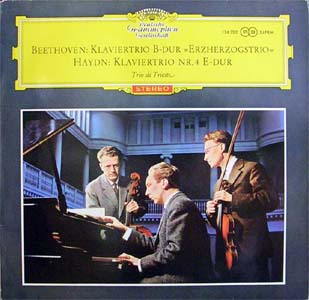 |
You may think this is only very slight change. So do I. however,
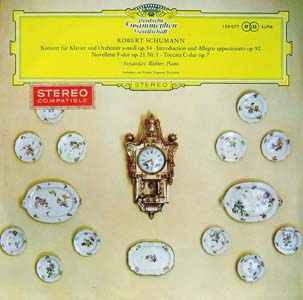 |
 |
The left is the first release jacket. Two completely different design in Red Stereo! Anyway, it is sure that DG changed the jacket designs whenever they reissued a number. I guess it depends on reissue time - if it was in red stereo era, new jacket for reissue seemed to have red stereo also. The more popular a issue, the more frequently this can be observed.
 |
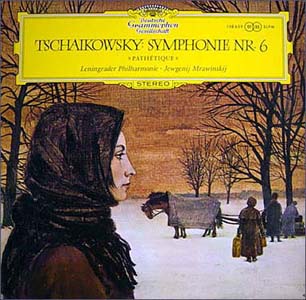 |
This
famous recording's first release jacket is the left
one(perhaps released on 1961~62). The later
release(right) has both red stereo(Sep. 1964)
and DGG at center(perhaps a bit later), and they
have Alle hersteller.
In short, the time sequence of the
first stereo releases can be represented by a diagram
though time is not exact strictly. Shaded zone at jacket
is marked for 'mixed used era' of DGG at center(with
or without SLPM and ST 33 Mark) and DG at center.

In
some cases there is black bold stereo between thin stereo
and red stereo. And, 'Made in Germany' can be in the 'Red
sticker' jacket.
Of course, exceptions exist. Famous
Rostropovich/Karajan's Dvorak Concerto & Tchaikovsky
Rococo variations(139 044 SLPM) is more or less strange.
DGG at center exists but none witnessed Made in
Germany as far as I know.
Go to ; 16~ , 17~ , 18~ , 19~ , 133~ , 136~ , 138~ , and 139~ serials
Sources
- Images
- Recording data
- Allmusic
- Deutsche Grammophon Gesellschaft
- Personal
homepages for artists
- My records & homepage discographies
- Special thanks to John Edward's 'Deutsche Grammophon Appreciation' site
- KEMPFF, Wilhelm
- FERRAS, Christian ; Julien Szulman's site
- SCHNEIDERHAN, Wolfgang ; a homepage for him(Japanese) & Japanese DG release only
- SCHERBAUM, Adolf
- DI STEFANO, Giuseppe
- JANOWITZ, Gundula
- STADER, Maria
- WUNDERLICH, Fritz
- Ferenc Fricsay discography
- JOCHUM, Eugen
- The archive of Herbert von Karajan(Japanese)
- KOCH, Helmut
- LEITNER, Ferdinand
- LUDWIG, Leopold
- MAAZEL, Lorin(Japanese)
- MRAVINSKY, Yevgeny
- SANDERLING, Kurt
- Complete Stereophonic discography of the Vienna Philharmonic Orchestra(Japanese)
- KATO Yukihiro's home
- The Durbeck archive
(c) 2006~, Youngrok LEE ; Link free, but please get my approval before you reuse, copy, or quote this materials.
Created ; 20th Jun. 2006
Last update ; 21st Oct. 2014